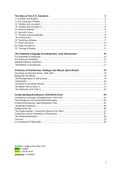Samenvatting
Summary MKDA History _ Early Modern
Summary of The Story of Art (Gombrich) chapters 11-18 and 20-23, The Classical Language of Architecture (Summerson) p. 7-88, A History of Architecture: Settings and Rituals (Kostof) p. 485-509, and Understanding Architecture (Roth-Roth Clark) p. 463-495.
[Meer zien]





